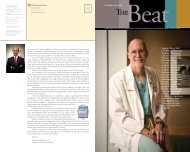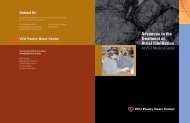Rakesh Kukreja, PhD, Jeanette and Eric Lipman Distinguished Professor in Cardiology Anindita Das, PhD, Assistant Professor Lei Xi, MD, Assistant Professor Fadi N. Salloum, PhD, Assistant ProfessorNew knowledge starts here.A foe so formidable as CVD has <strong>to</strong> be attacked on many fronts, which is exactly what thephysicians and scientists at <strong>Pauley</strong> <strong>Heart</strong> Center are doing. In basic science labs and clinicallabs, across subspecialties and disciplines, our research teams are working <strong>to</strong> discover newknowledge that will prevent CVD and improve care for CVD patients.In this issue of The Beat, we are focusing on the research efforts of Dr. Rakesh Kukrejaand his colleagues as they probe novel strategies for protecting the heart from injury associatedwith cardiac ischemia.“The major cause ofcardiovascular disease involvesischemia, which is basicallythe inefficient delivery ofoxygen <strong>to</strong> the cells of theheart, mainly the heart musclecells or cardiomyocytes,”Kukreja said. “These cells,after a period of stress, begindying and the efficiencyof the heart’s pumping actiondeclines. Additional damagecan occur with reperfusion,which is when bloodsupply returns <strong>to</strong> the tissueafter a period of ischemia, forinstance, after a heart attack.”“Our lab is studying pharmacologicaland physiological<strong>to</strong>ols that precondition theheart, making it more resistant<strong>to</strong> ischemic attacks, and thereforereducing or eliminatingthe damage from heart attack.”The value of Kukreja’sresearch is evidenced in hisfunding his<strong>to</strong>ry, as well as inhis designation as a NationalInstitutes of Health MERITinvestiga<strong>to</strong>r, which is an awardgiven <strong>to</strong> outstanding scientistswho are conducting researchof importance <strong>to</strong> NIH. Hehas been continuously fundedsince 1989 by NIH andcurrently has funding inexcess of $6 million for hisresearch projects.Kukreja’s research qualityand productivity was instrumentalin <strong>VCU</strong> recently beingawarded a $5 million grantfrom the NIH NationalCenter for Research Resourcesfor renovation of a state-ofthe-artcardiovascular researchcenter. The new facility willprovide necessary infrastructure<strong>to</strong> support greater depthand breath of cardiovascularinjury and repair research.Kukreja’s first majorbreakthrough came in 2002,when he and his colleaguesdiscovered that the most popularerectile dysfunction (ED)drug, sildenafil (Viagra)induced a powerful protectiveeffect against myocardialdamage after experimentalheart attack in animal models.Based on those extraordinaryresults, his lab has continued<strong>to</strong> expand the concep<strong>to</strong>f cardioprotection withED drugs, including tadalafil(Cialis) and vardenafil(Levitra) in ischemia/reperfusion injury, heartfailure and cardiomyopathycaused by myocardial infarction.The lab has continued<strong>to</strong> generate important newdiscoveries, including thefollowing:. Demonstrated, for thefirst time, that sildenafil(Viagra) directly protects adultcardiomyoctyes against necrosisand apop<strong>to</strong>sis followingischemia-reoxygenation injury.Sildenafil caused significantpreservation of mi<strong>to</strong>chondrialmembrane potential thatis essential for production ofATP and cellular homeostasis.These results suggest thatvasodilatation caused bysildenafil or the presence ofother cell types may notbe a prerequisite for the potentprotective effect of this drug.Sildenafil also induced earlyup-regulation of Bcl-2/Baxratio, which may have playedan important role in theantiapop<strong>to</strong>tic effect of thedrug in the heart.. Expanded the concept ofcardioprotection with PDE-5inhibi<strong>to</strong>rs by further showingattenuation in dilatedcardiomyopathy caused bydoxorubicin (DOX) or heartfailure caused by permanen<strong>to</strong>cclusion of coronary artery(myocardial infarction). Furthershowed that Viagra preventeddeath of heart cells, improvedsurvival of mi<strong>to</strong>chondria,preserved myofibrillar integrity,prevented heart dysfunctionand EKG abnormalities thatare consistent with thechronic <strong>to</strong>xicity associatedwith DOX.. Elucidated the in-depth roleof critical MAP kinase signalingpathway in activation ofnitric oxide synthesis pathwaysand protein kinase G (PKG)-dependent glycogen synthasekinase -3ß inactivation in sildenafil-inducedcardioprotection.. Demonstratied that tadalafil(Cialis) causes PKG-dependentgeneration of hydrogen sulfide(H2S), a new gaseous moleculewhich plays a critical rolein protection against ischemia/reperfusion injury. They areexpanding the investigation<strong>to</strong> study the role of H2Sin attenuation of doxorubicininducedcardiomyopathy.. For the first time, reportedthe role of microRNAs(miRNAs) in cardioprotection,MicroRNAs are noncodingRNAs of 18 <strong>to</strong> 24 nucleotidesthat are involved in posttranscriptionalregulation of proteinexpression. They showed thatischemic preconditioning of theheart synthesizes miRNAsthat reduce injury in the heartfollowing ischemia/reperfusioninjury through upregulatingcardioprotective proteinsincluding endothelial nitricoxide synthase, heat shockprotein 70 and its transcriptionfac<strong>to</strong>r HSF-1.“Our successes andproductivity are due in nosmall part <strong>to</strong> our talentedfaculty investiga<strong>to</strong>rs, as wellas the post-doc<strong>to</strong>ral fellows,clinical cardiology fellows,physician scientist-trackresidents, and undergraduatesthat rotate through our lab,”said Kukreja. “There arealso tremendous advantages<strong>to</strong> being part of a largemultidisciplinary academicmedical center, where thecross-fertilization of ideasis encouraged and discoveriesare translated faster in<strong>to</strong> theclinical environment wherepatients can benefit.”Ben Woolbright, PhD Student David Durrant, Lab SpecialistRamzi Ockaili, PhD, Research AssociateSai Sudha Koka, PhD, Postdoc<strong>to</strong>ral Fellow Shu-Guang Zhu, MD, PhD, Postdoc<strong>to</strong>rial Fellow
2009 <strong>Pauley</strong> <strong>Heart</strong> Center FellowsThe 2009 class of cardiovascular diseases, interventional and electrophysiologyfellows is full of familiar faces, with all but one having prior education, trainingor hospitalist service at <strong>Pauley</strong> <strong>Heart</strong> Center. This speaks volumes about thequality of students and trainees <strong>VCU</strong> Medical School and Medical Center attracts,as there are hundreds of applicants for each of our fellowship program positions.On completion of their training, these fellows will join the more than 200 ofour program alumni who are practicing in 32 states and several foreign countries.Anit Mankad, MD (Cardiovascular Disease)Darryn Apple<strong>to</strong>n, MD,distinguished himselfthroughout his residencyhere, earning several awardsincluding OutstandingJunior Resident and Housestaff Diagnostician in 2007,and serving as chief residentin 2008. His work withour faculty has resulted innumerous publicationsand presentations, includingarticles in American <strong>Heart</strong>Journal and American Journalof Cardiology and an oralpresentation at the 2007Darryn Apple<strong>to</strong>n, MD (Cardiovascular Disease)ACC meeting.Darryn was born in Auckland, New Zealand and received hismedical education at the University of Auckland. Following graduation,he did house staff training in New Zealand and the United Kingdom,as well as labora<strong>to</strong>ry training in Germany. His international backgroundis reflected in his hobbies and interests, which include sailing, travel,hiking and German language and culture.A native of Manhasset,New York, AndrewBinder, MD, is followingin his father’s footstepsin his choice of a careerin cardiology. Andrewreceived is undergraduatedegree in Biology fromBingham<strong>to</strong>n Universityand his MD from DrexelCollege of Medicine(Hahnemann) inPhiladelphia.Binder has beeninvolved in volunteeractivities throughout hisundergraduate andpost-graduate education,including service asa clinical assistant <strong>to</strong>Andrew Binder, MD (Cardiovascular Disease)the Salvation Army and<strong>to</strong> an outreach program for migrant farm workers, and as a peer advisor<strong>to</strong> freshman medical students. He also served on the <strong>VCU</strong> InternalMedicine’s Resident Life Committee, initiating and organizing socialevents for IM housestaff.While an intern and resident at <strong>Pauley</strong> <strong>Heart</strong> Center, Bindergave six presentations on a variety of subjects <strong>to</strong> Department of InternalMedicine faculty and housestaff. He also participated in a researchproject under the supervision of Dr. An<strong>to</strong>nio Abbate examining theutility of BNP measurements in patients with decompensated heartfailure. The work was accepted for presentation as a poster at the2008 ACC meeting.Anit Mankad, MD, hails from New Jersey, where he graduated summacum laude with a degree in Biology from Rutgers and earned his MDfrom the University of Medicine and Dentistry of New Jersey/RobertWood Johnson Medical School.During his internal medicine residency here, Mankad spentresearch time with Dr. An<strong>to</strong>nio Abbate that resulted in the submissionof a poster presentation featuring the case of a young adult with cardiacpheochromocy<strong>to</strong>ma. In the year between his residency and fellowship,he worked as a hospitalist at Henrico Doc<strong>to</strong>rs Hospital.Mankad’s interests include playing basketball 2-3 times a week,weight training and cheering on the Philadelphia Eagles.Pritam Polkampally, MD,received his medical degreefrom India’s premier medicalschool, the Armed ForcesMedical College in Pune,India. Following graduation,he completed a year ofinternship before immigrating<strong>to</strong> the U.S. for internalmedicine training at WrightState University BoonshoftSchool of Medicine.While a house officerat Wright State, Polkampallywas elected <strong>to</strong> Alpha OmegaAlpha Honorary Society.He also served as a chiefresident during his thirdPritam Polkampally, MD (Cardiovascular Disease)year and received theOutstanding Senior Resident of the Year award.Following the completion of his internal medicine residency,Polkampally worked on the hospitalist service at McGuire V. A. MedicalCenter in 2007-08. He collaborated extensively with Dr. On Topazand as a result now has eight manuscripts and three book chaptersin preparation, in press or published. In addition, he is co-investiga<strong>to</strong>ron two institutional research projects currently underway at the V. A.In the year prior <strong>to</strong> starting his cardiology training here,Polkampally was an Intramural Research Training Award Fellowin Cardiovascular Imaging at the National Institutes of Health inBethesda, Maryland.Syed Raza, MD, was born in Karachi, Pakistanand received his medical degree from Dow MedicalCollege in the same city. He immigrated <strong>to</strong> theU.S. in 2003 <strong>to</strong> continue his education, completinghis internal medicine residency at Michigan StateUniversity in 2006.During his residency, Raza served on theCode Blue Committee and was elected by his peers<strong>to</strong> serve as their representative on the GraduateMedical Education Committee. He also preparedand presented three posters at the regional AmericanCollege of Physicians meetings.Raza served as a hospitalist on Main 10Cardiology for two years before beginning his cardiology fellowship training.Syed’s hobbies include travel, pho<strong>to</strong>graphy, and playing cricketand squash.Syed Raza, MD (Cardiovascular Disease)Hong Jeong, MD, has beenat <strong>VCU</strong> since 2002 whenhe began his internal medicineinternship and residency,which he followed withcardiovascular disease training.He earned his MD at theUniversity of South FloridaCollege of Medicine andhis BS with honors from theUniversity of Florida.Jeong has garnerednumerous awards and honorsduring his education andtraining, including election <strong>to</strong>Phi Eta Sigma and Phi BetaKappa honor societies, andawards for House Staff MVPHong Jeong, MD (Interventional)and Outstanding Clinician.He has worked on several clinical research projects at <strong>Pauley</strong> <strong>Heart</strong>Center and has been a frequent presenter at Cardiac CatheterizationConferences, with subjects ranging from Transcatheter Closure of AtrialSeptal Defects <strong>to</strong> Drug Eluting Stent Implantation in ST ElevationMyocardial Infraction.Chris<strong>to</strong>pher King, MD, is afamiliar face on both the MCVCampus and at the V. A. as he justcompleted his cardiovascular diseasefellowship and is now training in ourinterventional cardiology program.His research includescollaborating with Dr. Mary AnnPeberdy and other National Registryof Cardio Pulmonary Resusitationinvestiga<strong>to</strong>rs <strong>to</strong> analyze CPRstatistics in an effort <strong>to</strong> improvecurrent guidelines and outcomes.King is a cum laude graduateof Samford University inBirmingham, Alabama, where hereceived his BS in Biology witha minor in Chemistry. He continuedChris<strong>to</strong>pher King, MD (Interventional)his education in Birmingham,earning his MD from The University of Alabama School of Medicineand doing his residency at University of Alabama Hospitals.King is a member of the ACC, SCAI, the AMA, the ACP andis currently serving on the AHA Council on Arteriosclerosis, Thrombosisand Vascular Biology and AHA Interdisciplinary Working Group onAtherosclerotic Peripheral Vascular DiseaseOyidie Igbokidi, MD, is thisyear’s sole fellow withoutprevious <strong>VCU</strong> education background,as she comes <strong>to</strong> ourinterventional cardiologyfellowship program from theUniversity of Iowa Hospitalsand Clinics where shecompleted her cardiovasculardisease training in 2006.In the years between hercardiology training and interventionaltraining she practicedwith Lewis-Gale Physiciansin Salem,Virginia.Igbokidi did herOyidie Igbokidi, MD (Interventional)internal medicine residencyat West Suburban Hospital in Oak Park, IL. She received her MBBS, theequivalent of an MD degree, from the University of Jos Medical Schoolin Nigeria.Igbokidi is board certified in internal medicine, cardiovasculardisease and is board eligible in nuclear cardiology.Daniel Alexander, DO, receivedhis undergraduate education at VPI,graduating with a BA in philosophyand a BS in biology. He earned hisDO from Kirksville College ofOsteopathic Medicine in Missouriand followed with a transitionalinternship at the National NavalMedical Center in Portsmouth,Virginia.Alexander served with theU. S. Marine Corps from June2001 – June 2003. As a BattalionSurgeon he was responsible for thehealth care of hundreds of marinesand sailors, including coordinationof medical assets and involvementin day-<strong>to</strong>-day combat operationsin support of Operation IraqiFreedom. He was awarded theDaniel Alexander, DO (Electrophysiology)Combat Action Ribbon, the GlobalWar on Terrorism Expedition Medal, and The Presidential Unit Citationin support of Operation Iraqi Freedom, December 2002-June 2003.On completion of his military service, Alexander did his internalmedicine residency at William Beaumont Hospital, Royal Oak Michiganand then came <strong>to</strong> <strong>VCU</strong> for his cardiovascular diseases fellowshiptraining. He began electrophysiology training this past July.Alexander’s current research is involved with examining thepotential mechanisms for recurrence of arrhythmias after ablation usingcryothermal methods. The principal investiga<strong>to</strong>r on the study isDr. Mark Wood.Alexander’s wife, Sherrie, works as an acute care nurse practitionerat <strong>Pauley</strong> <strong>Heart</strong> Center.





